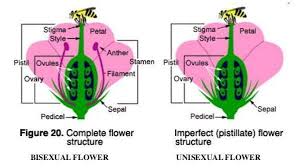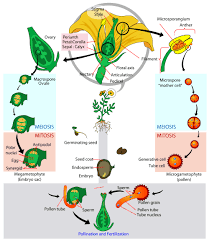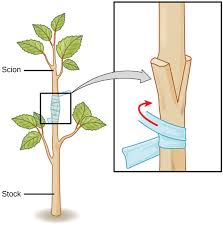Reproduction is a fundamental feature of all known life. Each individual organism exists as a result of reproduction. Reproduction is essential for the ‘Continuity of Life’ and without it, all life will cease to exist. This article is focused on reproduction in plants.
Reproduction (or procreation or breeding) is the biological process by which new individual organisms – “offspring” are produced from their “parents”.
There are two forms of reproduction in plants: Asexual and Sexual. In asexual reproduction, an organism can reproduce without the involvement of another organism, while sexual reproduction typically requires the sexual interaction of two specialised organisms.
This typically involves a male fertilising a female of the same species to create offspring whose genetic characteristics are derived from both parental organisms.
Plant reproduction is the process by which plants generate new individuals or offspring. Reproduction can be either sexual or asexual. Sexual reproduction involves the formation of offspring by the fusion of gametes.
Asexual reproduction involves the formation of offspring without the fusion of gametes. Sexual reproduction results in offspring that are genetically different from the parents. Asexual offspring are genetically identical, except for mutations.
In higher plants, offspring are packaged in protective seeds, which can be long-lived and can disperse offspring some distance from the parents. In flowering plants (angiosperms), the seed itself is contained inside a fruit, which may protect the developing seeds and aid in their dispersal.
Read Also: Factors Affecting the Performance of the Layer Chickens
Sexual Reproduction and Seed Development in Plants

Sexual reproduction in plants results from fertilisation, the union of gametes (cells that have undergone meiosis) from two genetically different plants. Meiosis reduces the number of chromosomes by half, producing gametes.
Fertilisation recombines gametes from different individuals, producing a zygote, which develops into either spores or seeds.
The main purpose of sexual reproduction is the rearrangement of genes in the next generation, which increases the genetic diversity of the population and enhances the evolutionary viability of the species in the face of changing environmental factors.
All plants have a life cycle that consists of two distinct forms that differ in size and the number of chromosomes per cell. In flowering plants, the large, familiar form consisting of roots, shoots, leaves, and reproductive structures (flowers and fruit) is diploid and is called the sporophyte.
The sporophyte produces haploid microscopic gametophytes that are dependent on tissues produced by the flower. The reproductive cycle of a flowering plant is the regular, usually seasonal, cycling from sporophyte to gametophyte.
The flower produces two kinds of gametophytes: male and female. The female gametophyte arises from a cell within the ovule, a small structure within the ovary of the flower.
The ovary is a larger structure that contains and protects many ovules. Flowering plants are unique because their ovules are entirely enclosed in the ovary.
The ovary itself is part of a larger structure called the carpel, which consists of the stigma, style, and ovary. Each ovule is attached to ovary tissue by a stalk called the funicle. The point of attachment of the funicle to the ovary is called the placenta.
The male gametophyte is the mature pollen grain. Pollen is produced in the anthers, which are attached to the filaments. The filament and anther together constitute the stamen, the male sex organ.
Through chemical recognition, the pollen tube changes its direction of growth and penetrates through the placenta to the ovule. The tube reaches the embryo sac near the micropyle, and sexual fertilisation occurs.
This involves the union of both male and female gametes, leading to the restoration of the number of chromosomes and the formation of a diploid zygote, which develops into the offspring. The resulting genetic composition has characteristics of both parent plants.
After fertilisation, the diploid zygote develops into the embryo, and the triploid endosperm cells multiply to provide nutrition. The testa usually shows a scar called the hilum, where the ovule was originally attached to the funicle.
In some seeds, a ridge along the testa called the raphe shows where the funicle was pressed against the ovule. The micropyle of the ovule usually survives as a small pore in the seed coat, allowing the passage of water during seed germination.
The embryo consists of cotyledons, epicotyl, and hypocotyl. Cotyledons resemble small leaves and are usually the first photosynthetic organs of the plant. The portion above the cotyledons is the epicotyl, and the portion below is the hypocotyl.
The epicotyl is an apical meristem that produces the shoot of the growing plant and the first true leaves after germination. The hypocotyl develops into the root. Often, the tip of the hypocotyl, the radicle, is the first indication of germination as it breaks out of the seed.
Flowering plants are classified as monocotyledons or dicotyledons (now called eudicots) based on the number of cotyledons produced in the embryo.
Common monocotyledons include grasses, sedges, lilies, irises, and orchids; common dicotyledons include sunflowers, roses, legumes, and non-coniferous trees.
The endosperm may be consumed by the embryo, as in many legumes, which use the cotyledons as a food source during germination. In other species, the endosperm persists until germination, when it is used as food.
Sexual Reproduction and Fruit Development in Plants

The fruit of a flowering plant is the mature ovary. As seeds mature, the surrounding ovary wall forms a protective structure that aids in dispersal. The surrounding ovary tissue is called the pericarp and consists of three layers: exocarp, mesocarp, and endocarp.
The exocarp is usually tough and skin-like, the mesocarp is often thick, succulent, and sweet, and the endocarp surrounds the seeds, which may be hard and stony, as in species with fleshy fruit, such as mangoes.
A fruit is termed simple if it is produced by a single ripened ovary in a single flower (apples, oranges). An aggregated fruit is a cluster of mature ovaries produced by a single flower (blackberries, strawberries).
A multiple fruit is a cluster of many ripened ovaries on separate flowers growing together in the same inflorescence (pineapple). A simple fruit may be fleshy or dry. Fleshy simple fruits include berries (grape, tomato, papaya), pepos (cucumber, watermelon, pumpkin), hesperidiums (orange), drupes (apricot), or pomes (apple).
Dry simple fruits have a dry pericarp at maturity and may or may not dehisce, or split, along a seam to release the seeds. A dehiscent dry fruit is classified as a legume or pod (pea, bean), silique or silicle (mustard), capsule (poppy, lily), or follicle (milkweed, larkspur).
An indehiscent dry fruit that does not split to release seeds is classified as an achene (sunflower, buttercup, sycamore), grain or caryopsis (grasses such as corn, wheat, rice, barley), schizocarp (carrot, celery, fennel), winged samara (maple, ash, elm), nut (acorn, chestnut, hazelnut), or utricle (duckweed family).
Some fruiting bodies contain non-ovary tissue and are sometimes called pseudocarps, such as the sweet flesh of apples and pears, which is composed of the receptacle of the flowering shoot.
Fruiting bodies protect and disperse the seeds they contain. Protection can be physical (hard coverings) or chemical (repellents of seed predators). Sweet, fleshy fruits attract birds and mammals that consume seeds along with the fruit and pass the seeds intact in their feces, which acts as fertilizer.
Read Also: How To Recycle Different Waste Products
Dry fruits are usually adapted for wind dispersal of seeds, with the assistance of wing-like structures or a fluffy pappus that provides buoyancy. The diversity of fruiting bodies reflects the diversity of dispersal agents, which select for different fruit sizes, shapes, and chemistry.
Asexual Reproduction in Plants

The ability to produce new individuals asexually is common in plants. In asexual reproduction, new plants are produced that are genetically identical clones of the parent plant, without the contribution of genetic material from another plant. Asexual reproduction in plants can be divided into two categories: vegetative reproduction and apomixis.
1. Vegetative Reproduction in Plants
When a vegetative piece of the original plant, such as root, stem, or leaf, is involved in producing an offspring, it is known as vegetative reproduction in plants. This process is often referred to as the ‘survival’ and expansion of biomass. Examples of vegetative reproduction include:
i. Budding: In budding, a new organism develops from an outgrowth or bud due to cell division at a specific site. The new organism remains attached to the parent plant until it matures and separates, leaving behind scar tissue. For example, yeast reproduces by this method.
ii. Fragmentation: Fragmentation is a form of asexual reproduction where an organism splits into fragments, each of which develops into a mature, fully grown individual that is a clone of the original organism. Algae such as Spirogyra reproduce by fragmentation.
iii. Spore Formation: Spore formation, or sporogenesis, is the process of reproduction in plants via spores. Reproductive spores grow into multicellular haploid individuals (sporelings).
Spores have a protective outer covering to withstand unfavorable conditions such as high temperatures and low humidity, enabling survival until favorable conditions arise. Fungi, mosses, and ferns reproduce by spores.
2. Vegetative Propagation in Plants
Vegetative propagation is a type of asexual reproduction where new plants are produced from roots, stems, leaves, or buds. Since reproduction occurs through the vegetative parts of the plant, this method is known as vegetative propagation.
3. Differences Between Sexual and Asexual Reproduction in Plants
The key differences between sexual and asexual reproduction in plants are as follows:
i. Sexual reproduction requires both male and female parent plants, while asexual reproduction occurs through a single parent plant.
ii. Sexual reproduction occurs in bisexual plants, while asexual reproduction can occur in unisexual plants.
iii. Morphologically developed plants use sexual reproduction, while morphologically underdeveloped plants use asexual reproduction.
iv. Sexual reproduction involves fully developed reproductive parts such as the anther and pistil, whereas asexual reproduction involves undeveloped reproductive parts.
v. In sexual reproduction, the original parent continues to exist after reproduction, while in most asexual reproduction methods, the original parent ceases to exist after reproduction.
vi. In sexual reproduction, offspring inherit characteristics from both parent plants, while in asexual reproduction, offspring are genetically identical to the parent plant.
vii. Seeds are required for sexual reproduction, but no seeds are required for asexual reproduction.
Reproduction in plants, through either sexual or asexual mechanisms, is crucial in the fields of agriculture, horticulture, and floriculture. Understanding these mechanisms enables healthy crops to be cultivated using scientific agricultural practices, ultimately leading to higher yields.
Do you have any questions, suggestions, or contributions? If so, please feel free to use the comment box below to share your thoughts. We also encourage you to kindly share this information with others who might benefit from it. Since we can’t reach everyone at once, we truly appreciate your help in spreading the word. Thank you so much for your support and for sharing!
